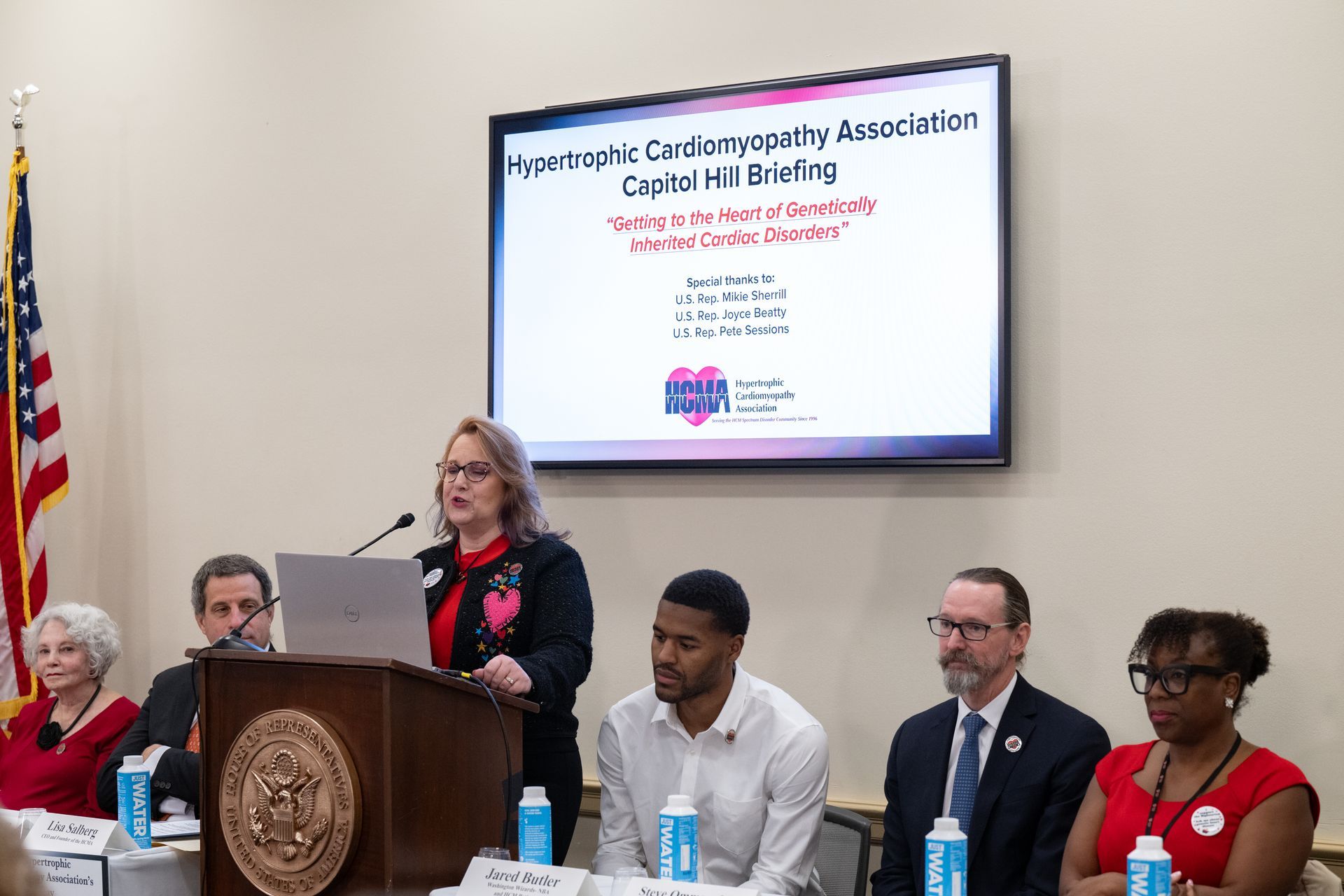
Quick summary
Since around 1990, HCM has been regarded as a disease caused entirely by single mutation s in genes affecting a protein in the cardiac sarcomeres. There is no doubt that sarcomere mutations play an important role. But in the last several years, there has been a growing realization among researchers that this cannot be the entire explanation for the causes of HCM. This is because a majority of HCM patients do not appear to carry these mutations, and many people who do carry them never develop HCM. The development and inheritance of HCM are more complicated than was previously thought. However, for patients, many of the lessons previously taught about HCM genetics remain true. Current research may open the way to a much-improved understanding of HCM .
What causes HCM?
What causes HCM? Certain gene mutations (especially in the protein myosin in the heart muscle structures called cardiac sarcomeres ) have been known to be important since 1989-1990 (Jarcho et al. 1989; Solomon et al. 1990). Since then, it seemed that nearly all HCM would be explained this way (Ho and Seidman 2006, Burke et al. 2016). That would be great! If we understood the basis of almost all HCM, we might be able to predict which family members of HCM patients are at most risk of developing HCM. It may even become possible to tune therapies to specific mutations.
Reasons to look for broader answers
But in the last several years, most HCM researchers and specialists have revised their understanding of HCM genetics. Sarcomere mutations play a big role in contributing to HCM. But despite identifying more and more of these mutations (there are more than 1000 currently known), they still explain only about a third (Bos et. al 2014; Gruner et al. 2013) or fewer;(Bonaventura et al. 2019 , Hathaway et al. 2021) of the cases of HCM. What makes matters worse, it’s not uncommon for some people with these mutations to go through life free of HCM.
All of this makes it difficult to continue to believe that HCM is generally a disease caused by single mutations in the sarcomere (or, in the jargon of genetics, an autosomal dominant mutation). Leading researchers today are investigating broader hypotheses about the causes of HCM (Maron et al. 2019, Harper et al. 2021, Watkins 2021).
What are the other possibilities?
If HCM isn’t mainly explained by mutations in single genes, what are the other possibilities? Most variation in physical characteristics (phenotypes) is caused by a combination of
- Variation in multiple genes;
- The ways the genes are regulated;
- The effects of the environment; and
- The ways genes affect each other’s expression.
All of these are reasons we speak of mutations as “contributing to” HCM or “promoting” HCM.
Genetics can be complicated!
This isn’t what we all learned in school about genetics. But if you think about it, is it surprising to hear that your teacher’s story was a simplified explanation? After all, if the school science class story was all there was to it, why would we still have people who study how genes work? Some traits work in that simple way, but most don’t.
Which lessons about HCM genetics are unchanged?
A lot of what you have learned about HCM genetics is still the case, including these points:
- Each copy of each gene you have (you have 2 of each) has a 1 in 2 (50%) chance of being passed to each child.
- If you have one of the sarcomere mutations known to promote HCM, each of your children has a 50% chance of inheriting that gene mutation. Their chance of inheriting HCM itself is less than 50% since not everyone with one of these mutations develops disease.
- If you have HCM but no known mutation, your kids still have a chance of inheriting HCM. We don’t know what that chance is, though, because we don’t understand all the causes of HCM. There is some evidence suggesting that people with non-sarcomere HCM don’t pass on the phenotype as easily as those with sarcomere HCM.
- A “genetic test” doesn’t test whether your HCM is (partly) caused by genes. It tests whether you have one of the known mutations. In other words, a negative genetic test doesn’t mean you can’t pass your HCM on to your kids. The reason for testing isn’t to exclude YOU, it’s to possibly exclude them from further concern – if you have a known mutation and they don’t, then their chances of developing HCM are exceedingly small.
- You did not get HCM by eating poorly or failing to exercise. There is no evidence at all for that!
Looking ahead
It may be challenging to process the idea that HCM has more complex causes than previously thought. But humans are complex organisms. Even something as seemingly simple as eye color can be complicated (Mackey 2021). Since the sarcomere mutations we know can cause HCM only account for 30% of cases, we have to keep looking to see if we can find out what’s going on in the majority of HCM cases. The fact that researchers have recognized this means that they can move forward in studying the causes of HCM!
There is a lot to be learned about the causes of HCM.
Learn more about genetics on HCM Awareness Day: https://4hcm.org/hcm-awareness-day/
Literature cited
- Bonaventura, J., P. Norambuena, P. Tomasov, P. Jindrová, H. Šedivá, M. Macek Jr, J. Veselka. 2019. The utility of the Mayo Score for predicting the yield of genetic testing in patients with hypertrophic cardiomyopathy. Archives of Medical Science 15: 641-649. https://www.ncbi.nlm.nih.gov/pmc/articles/PMC6524174/pdf/AMS-15-33903.pdf
- Bos, J. M., M.L. Will, B.J. Gersh, T.M. Kruisselbrink, S.R. Ommen, M.J. Ackerman. 2014. Characterization of a phenotype-based genetic test prediction score for unrelated patients with hypertrophic cardiomyopathy, Mayo Clinic Proceedings 89: 727-737. https://www.sciencedirect.com/science/article/abs/pii/S0025619614001487
- Burke, M. A., S. A. Cook, J. G. Seidman, and C. E. Seidman. 2016. Clinical and mechanistic insights into the genetics of cardiomyopathy. Journal of the American College of Cardiology 68:2871–2886. https://www.sciencedirect.com/science/article/pii/S0735109716368231?via%3Dihub
- Gruner, C., J. Ivanov, M. Care, et al. 2013. Toronto hypertrophic cardiomyopathy genotype score for prediction of a positive genotype in hypertrophic cardiomyopathy. Circulation: Cardiovascular Genetics 6: 19-26. https://www.ahajournals.org/doi/full/10.1161/CIRCGENETICS.112.963363
- Harper, A. R., A. Goel, C. Grace, K. L. Thomson, S. E. Petersen, X. Xu, A. Waring, E. Ormondroyd, C. M. Kramer, C. Y. Ho, S. Neubauer, R. Tadros, J. S. Ware, C. R. Bezzina, M. Farrall, & H. Watkins. 2021. Common genetic variants and modifiable risk factors underpin hypertrophic cardiomyopathy susceptibility and expressivity. Nature Genetics 53:135–142. https://doi.org/10.1038/s41588-020-00764-0
- Hathaway, J., K. Helio, I. Saarinen, et al. 2021. Diagnostic yield of genetic testing in a heterogeneous cohort of 1376 HCM patients. BMC Cardiovascular Disorders : 121-126. https://pubmed.ncbi.nlm.nih.gov/33673806/
- Ho, C. Y., and C. E. Seidman. 2006. A contemporary approach to hypertrophic cardiomyopathy. Circulation 113:e858–e862. https://www.ahajournals.org/doi/10.1161/circulationaha.105.591982
- Jarcho, J. A., W. McKenna, J. A. Pare, S. D. Solomon, R. F. Holcombe, S. Dickie, T. Levi, H. Donis-Keller, J. G. Seidman, C. E. Seidman. 1989. Mapping a gene for familial hypertrophic cardiomyopathy to chromosome 14q1. New England Journal of Medicine 16:1372-8. https://www.scopus.com/record/display.uri?eid=2-s2.0-0024426784&origin=inward
- Mackey, D.A. 2021. What colour are your eyes? Teaching the genetics of eye colour & colour vision. Edridge Green Lecture RCOphth Annual Congress Glasgow May 2019. Eye (2021). https://doi.org/10.1038/s41433-021-01749-x
- Maron, B. J., Maron, M. S., Maron, B. A., & Loscalzo, J. 2019. Moving beyond the sarcomere to explain heterogeneity in hypertrophic cardiomyopathy: JACC Review Topic of the Week. Journal of the American College of Cardiology 73:1978–1986. https://doi.org/10.1016/j.jacc.2019.01.061
- Solomon, S. D., J. A. Jarcho, W. McKenna, A. Geisterfer-Lowrance, R. Germain, R. Salerni, J. G. Seidman, C. E. Seidman. 1990. Familial hypertrophic cardiomyopathy is a genetically heterogeneous disease. Journal of Clinical Investigation 86:993-9. https://www.scopus.com/record/display.uri?origin=recordpage&zone=relatedDocuments&eid=2-s2.0-0025104401&noHighlight=false&relpos=0
- Watkins, H. 2021. Time to think differently about sarcomere-negative hypertrophic cardiomyopathy. Circulation 143: 2415–2417. https://doi.org/10.1161/CIRCULATIONAHA.121.053527
The post Updated thinking on HCM genetics appeared first on Hypertrophic Cardiomyopathy Association.
HCMA Blog


 Translate
Translate
